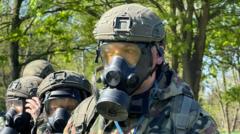Ordinary citizens from diverse backgrounds gather at a military training site in Wroclaw, Poland, as tensions with Russia escalate. Many ordinary Poles are signing up for military training sessions, eager to equip themselves with the skills needed for potential defense. Captain Adam Sielicki, an instructor of the program dubbed "Train with the Army," emphasizes the necessity for citizens to be ready for the possibility of armed conflict. "The times are dangerous now, we need to be ready," he states, noting the oversubscription of the program and plans to expand training to every adult male in Poland.
Poland's military spending is on the rise, projected to reach nearly 5% of GDP this year—an unprecedented figure within NATO. Prime Minister Donald Tusk has articulated ambitions to construct "the strongest army in the region," with significant investments in equipment and technology from international partners like the United States and South Korea. Participants like Dariusz are resolute in their commitment: "History has taught us that we must be prepared to defend ourselves on our own."
The concerns aren't solely rooted in domestic sentiments; international dynamics, particularly remarks from the previous U.S. administration regarding NATO's presence in Europe, have intensified worries about national security. The planned withdrawal of U.S. troops from a military base in Rzeszow adds to the unease. Poland is seeking new defense agreements with countries such as France and the UK as it reevaluates its reliance on U.S. military support.
The impact of historical events weighs heavily on the Polish psyche. Ninety-eight-year-old Wanda Traczyk-Stawska vividly recalls the last Russian invasion and emphasizes the importance of military readiness. Poland's armed forces currently consist of around 216,000 personnel, with aspirations to expand to half a million to solidify its status in NATO.
Increasing fears have sparked interest in protective measures among civilians. Demand for bomb shelters has surged, with businesses reporting dozens of inquiries each week. Yet, public sentiment reveals a divide; recent polls indicate that only a small fraction of the adult population would take up arms in the event of war, while many express intentions to flee if conflict arises.
On the ground, young Polish students exhibit varied reactions to the potential of conflict, with some expressing readiness to escape rather than respond defensively. In a landscape fraught with anxiety and historical awareness, the populace grapples with the realities of their security and sovereignty amidst uncertainty.
Poland's military spending is on the rise, projected to reach nearly 5% of GDP this year—an unprecedented figure within NATO. Prime Minister Donald Tusk has articulated ambitions to construct "the strongest army in the region," with significant investments in equipment and technology from international partners like the United States and South Korea. Participants like Dariusz are resolute in their commitment: "History has taught us that we must be prepared to defend ourselves on our own."
The concerns aren't solely rooted in domestic sentiments; international dynamics, particularly remarks from the previous U.S. administration regarding NATO's presence in Europe, have intensified worries about national security. The planned withdrawal of U.S. troops from a military base in Rzeszow adds to the unease. Poland is seeking new defense agreements with countries such as France and the UK as it reevaluates its reliance on U.S. military support.
The impact of historical events weighs heavily on the Polish psyche. Ninety-eight-year-old Wanda Traczyk-Stawska vividly recalls the last Russian invasion and emphasizes the importance of military readiness. Poland's armed forces currently consist of around 216,000 personnel, with aspirations to expand to half a million to solidify its status in NATO.
Increasing fears have sparked interest in protective measures among civilians. Demand for bomb shelters has surged, with businesses reporting dozens of inquiries each week. Yet, public sentiment reveals a divide; recent polls indicate that only a small fraction of the adult population would take up arms in the event of war, while many express intentions to flee if conflict arises.
On the ground, young Polish students exhibit varied reactions to the potential of conflict, with some expressing readiness to escape rather than respond defensively. In a landscape fraught with anxiety and historical awareness, the populace grapples with the realities of their security and sovereignty amidst uncertainty.

















